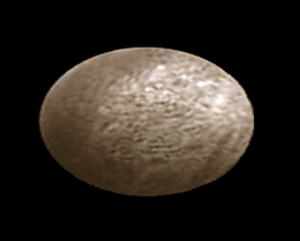20000 Varuna facts for kids

Artist's idea of what Varuna may look like |
|
| Discovery | |
|---|---|
| Discovered by | R. McMillan (Spacewatch) |
| Discovery date | 28 November 2000 |
| Designations | |
| MPC designation | 20000 Varuna |
| 2000 WR106 | |
| TNO (cubewano) | |
| Orbital characteristics | |
| Epoch 14 July 2004 (JD 2453200.5) | |
| Aphelion | 6 781.985 Gm (45.335 AU) |
| Perihelion | 6 120.810 Gm (40.915 AU) |
| 6 451.398 Gm (43.129 AU) | |
| Eccentricity | 0.051 |
| 103 440.6 d (283.20 a) | |
|
Average orbital speed
|
4.53 km/s |
| 89.673° | |
| Inclination | 17.2° |
| 97.296° | |
| 271.631° | |
| Physical characteristics | |
| Dimensions | 800 km (avg of thermals) (scalene ellipsoid)? |
| Mass | ≈3.7×1020? kg |
|
Mean density
|
0.992 g/cm³ |
| 0.15 m/s² | |
| 0.39 km/s | |
|
Sidereal rotation period
|
0.132 16 d (3.17 h) |
| Albedo | 0.037–0.26 |
| Temperature | ≈43–41 K |
|
Spectral type
|
(moderately red) B-V=0.93 V-R=0.64 |
| 19.9 (opposition) | |
| 3.7 | |
20000 Varuna is a very large object located in the Kuiper belt. The Kuiper belt is a huge ring of icy bodies found beyond the planet Neptune. Varuna is so big that scientists think it might be a dwarf planet, similar to Pluto.
Before it was officially named Varuna, this object had a temporary name called a provisional designation. Its provisional name was 2000 WR106. Varuna got its permanent name from Varuṇa, a god in Hindu stories.
What is Varuna Like?
Varuna spins around quite quickly. It completes one full spin in about 3.17 hours. Because it spins so fast for its size, scientists believe Varuna is shaped like a stretched-out ball, not a perfect sphere. Imagine a rugby ball or an American football, but in space!
The material that makes up Varuna is thought to be very similar to water. Its density is about 1 gram per cubic centimeter, which is close to the density of water.
The surface of Varuna has a slightly reddish color. Scientists have also found small amounts of water ice on its surface. This tells us a bit about what Varuna is made of and what it might look like up close.
| The Solar System | |||||||
|---|---|---|---|---|---|---|---|
|
|
|||||||
| Sun • Heliosphere |
Planets ☾ = moon(s) ∅ = rings |
Mercury | Venus | Earth ☾ | Mars ☾ | ||
| Jupiter ☾ ∅ | Saturn ☾ ∅ | Uranus ☾ ∅ | Neptune ☾ ∅ | ||||
| Dwarf planets | Ceres | Pluto ☾ | Haumea ☾ | Makemake | |||
| Eris ☾ | |||||||
| Small Solar System bodies |
Asteroids (minor planets) |
Groups and families: Vulcanoids · Near-Earth asteroids · Asteroid belt Jupiter Trojans · Centaurs · Neptune Trojans · Asteroid moons · Meteoroids · Pallas · Juno · Vesta · Hygiea · Interamnia · Europa |
|||||
| See also the list of asteroids. | |||||||
| Trans- Neptunians |
Kuiper belt – Plutinos: Orcus · Ixion – Cubewanos: Varuna · Quaoar · Huya |
||||||
| Scattered disc: Sedna | |||||||
| Comets | Periodic comets and non-periodic comets Damocloids · Oort cloud |
||||||
| See also the list of solar system objects | |||||||
Images for kids
-
Varuna was discovered using a special telescope at the Kitt Peak National Observatory.
See also
 In Spanish: (20000) Varuna para niños
In Spanish: (20000) Varuna para niños





